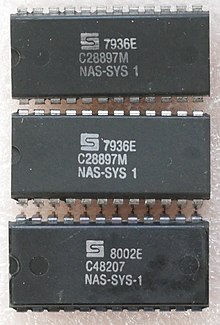Nascom
[4] During a business trip to California in the Autumn of 1976, Marshall attended an amateur computer club meeting at Stanford University.Marshall used the price of an SLR camera (about £200) as a reference point for the amount someone might be prepared to spend on a "hobby" purchase.[2] At the end of 1976, Marshall attended a microprocessor seminar at Imperial College and met Phil Pitman.[1] Most of the details of the Nascom design were described in a series of articles by Pitman that appeared in Wireless World between November 1977 and January 1979.[5] By July 1977, monthly magazine adverts by Lynx Electronics were starting to hint about a microprocessor seminar in the autumn and a forthcoming computer product.[6] On Saturday, 26 November 1977, Lynx Electronics launched the Nascom 1 at their "Home Microcomputer Symposium" at Wembley Conference Centre, London.An article in that issue[9] by K. S. Borland (another director of Nasco Sales Ltd) described the origins and history of the Nascom 1 design.[10] After the success of their seminar in Wembley, Lynx electronics held a similar event in Manchester (Saturday, 1 April 1978.By July 1978, The Micronics Company was advertising a cased, built and tested Nascom 1 (with power supply) for £399 + VAT.By January 1979, Lynx Electronics had appointed multiple dealers in the UK and were advertising as Nascom Microcomputers, with the "nm" logo.[16] By November 1979 Nascom had decided to relaunch the product with a 16Kbyte DRAM board and NASBUS interconnect but to keep the price at £295 + VAT.Grovewood appointed Messrs Cork Gully, and Marshall resigned from the company to start a new business, Gemini Computers.An annotated disassembly listing of the Nascom 2 Microsoft ROM BASIC was published[26] and the code was subsequently re-purposed in retrocomputing projects such as Grant Searle's Multicomp and Spencer Owen's RC2014.The frame improves reliability by preventing the force of repeated keystrokes from being transmitted to the solder joints that connect the key switches to the PCB.The International Nascom Microcomputer Club (INMC) published a "snow plough" design that reduced the effect by blanking the video when simultaneous access occurred.[30] The Nascom 2 used a slightly different design but still allowed contention to occur, this time giving rise to black flicker (blanking) on the screen.All of the debug monitors provided similar capabilities, with different levels of sophistication: As the user-base grew, user-group magazines published type-in programs either in assembly language or as hexadecimal dumps or (later) in BASIC.The Nascom 2 generated the NAS-BUS directly on an 80-way (79-way plus polarising slot) 0.1" pitch gold-plated edge connector on its PCB.British Cellophane used several to continuously monitor thickness gauges attached to plastic sheet production lines.





NASCOMsingle-board computerUnited KingdomZilog Z80keyboardserial porttape cassetteKansas City standardparallel portsvideo displaymicrocomputerhexadecimalseven-segment displaydebug monitoroperating systemsemiconductorsStanford UniversitySLR cameramicroprocessorWembley Conference CentreLondonsymposiumWembleyManchesterLucas Industriesdisassemblyretrocomputingsource codeGitHubcassette recorderintegrated-circuitselectronic componentsbipolarglue logiccharacter-generatorsolid-statefibreglassMicrosoft BASICdescendersassembly languagecassette tapetype-in programsPersonal Computer WorldPractical ComputingComputing TodayAnders HejlsbergPolyMorphic SystemsPoly-88BorlandTurbo Pascalcompilerintegrated development environmentBritish CellophaneKenilworthMCDU1 and MCDU2